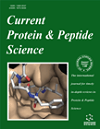- Home
- A-Z Publications
- Current Protein and Peptide Science
- Previous Issues
- Volume 25, Issue 2, 2024
Current Protein and Peptide Science - Volume 25, Issue 2, 2024
Volume 25, Issue 2, 2024
-
-
Protein Engineering in Cyanobacterial Biotechnology: Tools and Recent Updates
More LessAuthors: Swati Tyagi, Srabani Kar, Amit Srivastava and Pratyoosh ShuklaCyanobacteria have emerged as a microbial cell factory to produce a variety of bioproducts, including peptides and proteins. Cyanobacteria stand out among other organisms due to their photoautotrophic metabolism and ability to produce a wide range of metabolites. As photoautotrophic hosts can produce industrial compounds and proteins by using minimal resources such as sunlight, atmospheric carbon dioxide, and few Read More
-
-
-
Plant bZIP Proteins: Potential use in Agriculture - A Review
More LessWith global climate changes and the increased demand for food due to expected world population growth, genetic improvement programs have aimed at producing crops with increased yield and tolerance to environmental stresses, such as drought, salinity, and pathogens. On the other hand, genetic improvement programs via biotechnology require candidate genes that confer traits of interest to be incorporated into im Read More
-
-
-
Research Progress on hCNT3 Structure/Function and Nucleoside Anticancer Drugs
More LessAuthors: Xinru Yue, Xun Zhang, Derong Zhang, Zhigang Zhang, Lingkai Tang, Zuoxin Ou, Yujie Cao, Jing Li, Ying Li, Li Liang, Wei Liu and Jianping HuMembrane protein human concentrative nucleoside transporter 3 (hCNT3) can not only transport extracellular nucleosides into the cell but also transport various nucleoside-derived anticancer drugs to the focus of infection for therapeutic effects. Typical nucleoside anticancer drugs, including fludarabine, cladabine, decitabine, and clofarabine, are recognized by hCNT3 and then delivered to the lesion site for their ther Read More
-
-
-
ARL15 and its Multiple Disease Association: Emerging Functions and Potential Therapeutic Application
More LessAuthors: Manisha Saini, Varnita Anand, Aditya Sharma, Anuj Pandey, Bittianda K. Thelma and Suman KunduARL15 is a member of the RAS superfamily of small GTPases and is associated with several metabolic traits, including increased risk of diabetes, rheumatoid arthritis and lipid metabolism disorders. The ARL15 gene encodes for an uncharacterized small GTP binding protein. Its precise role in human physiology remains unknown, but several genetic association studies have recognized different variants in this gene to be statisti Read More
-
-
-
Advancements of the CRISPR/Cas9 System in the Treatment of Liver Cancer
More LessAuthors: Zhuoyu Li and Ziming HanIn recent years, the CRISPR/Cas9 system has become a rapidly advancing gene editing technology with significant advantages in various fields, particularly biomedicine. Liver cancer is a severe malignancy that threatens human health and is primarily treated with surgery, radiotherapy, and chemotherapy. However, surgery may not be suitable for advanced cases of liver cancer with distant metastases. Moreover, radiothera Read More
-
-
-
Current Stage and Future Perspectives for Homology Modeling, Molecular Dynamics Simulations, Machine Learning with Molecular Dynamics, and Quantum Computing for Intrinsically Disordered Proteins and Proteins with Intrinsically Disordered Regions
More LessAuthors: Orkid Coskuner-Weber and Vladimir N. UverskyThe structural ensembles of intrinsically disordered proteins (IDPs) and proteins with intrinsically disordered regions (IDRs) cannot be easily characterized using conventional experimental techniques. Computational techniques complement experiments and provide useful insights into the structural ensembles of IDPs and proteins with IDRs. Herein, we discuss computational techniques such as homology modeling, molecul Read More
-
-
-
Purification, Characterization and Evaluation of the Anticoagulant Effect of an Uncompetitive Trypsin Inhibitor obtained from Bauhinia pulchella (Benth) Seeds
More LessIntroduction: Trypsin inhibitors (TIs) have the ability to competitively or non-competitively bind to trypsin and inhibit its action. These inhibitors are commonly found in plants and are used in protease inhibition studies involved in biochemical pathways of pharmacological interest. Objectives: This work aimed to purify a trypsin inhibitor from Bauhinia pulchella seeds (BpuTI), describing its kinetic mechanism and anticoagulant effect. Read More
-
-
-
Markers of Oxidative Stress and Tyrosinase Activity in Melasma Patients: A Biochemical Investigation
More LessAuthors: Shweta Katiyar, Dhananjay Yadav and Sanjeev K. SinghBackground: Melasma is a skin hyperpigmentary disorder that develops over time. Genetic factors, oxidative stress, female sex hormones, and UV light may all play a role in the disorder's progression. Aims: To compare the levels of oxidative stress and tyrosinase activity in melasma patients with healthy volunteers. Methods: After written consent, 130 patients were enrolled in a case–control study. 65 cases were of melasma d Read More
-
Volumes & issues
-
Volume 26 (2025)
-
Volume 25 (2024)
-
Volume 24 (2023)
-
Volume 23 (2022)
-
Volume 22 (2021)
-
Volume 21 (2020)
-
Volume 20 (2019)
-
Volume 19 (2018)
-
Volume 18 (2017)
-
Volume 17 (2016)
-
Volume 16 (2015)
-
Volume 15 (2014)
-
Volume 14 (2013)
-
Volume 13 (2012)
-
Volume 12 (2011)
-
Volume 11 (2010)
-
Volume 10 (2009)
-
Volume 9 (2008)
-
Volume 8 (2007)
-
Volume 7 (2006)
-
Volume 6 (2005)
-
Volume 5 (2004)
-
Volume 4 (2003)
-
Volume 3 (2002)
-
Volume 2 (2001)
-
Volume 1 (2000)
Most Read This Month
Article
content/journals/cpps
Journal
10
5
false
en


